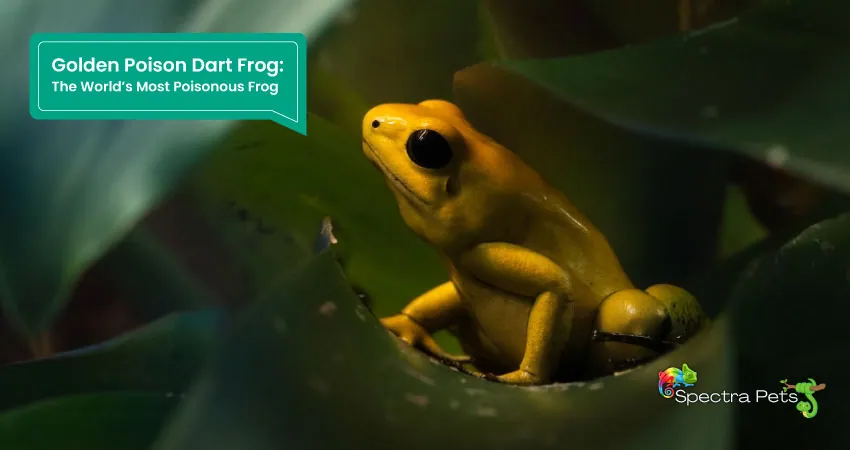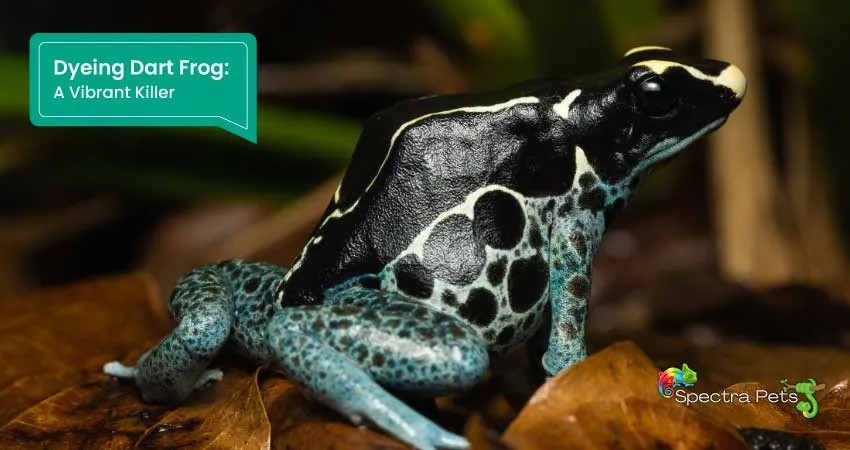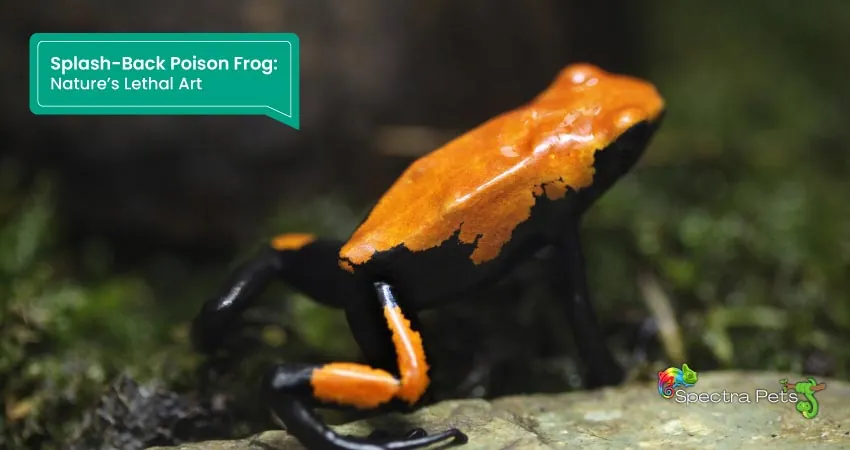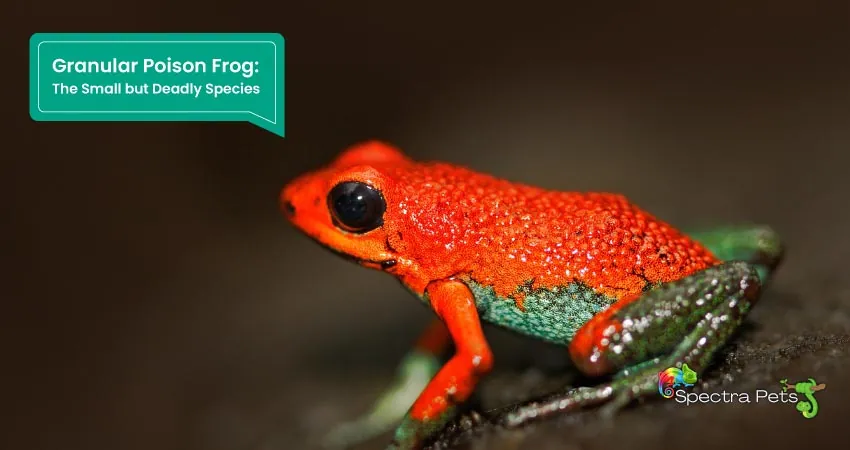Frogs, belonging to the order Anura, are known for their remarkable diversity, with over 7,000 species found across the globe. Among these, a select few have evolved an astonishing defense mechanism: the production of potent toxins. These toxins serve as a deterrent to predators, signaling that the frog is dangerous or unpalatable. Some of these frogs, such as those in the family Dendrobatidae, secrete toxins so potent that they are among the most lethal creatures on the planet. Research published in the journal “Toxicon” has revealed that a single gram of toxin from the skin of the Golden Poison Dart Frog (Phyllobates terribilis) can kill up to 20,000 mice or approximately two African elephants.
So, what makes these frogs the most deadly in the world? The answer lies in the potency and complexity of their skin toxins. For example, Batrachotoxin, a potent neurotoxin found in poison dart frogs, binds to sodium channels in nerve cells, leading to rapid paralysis and death. A minuscule amount—just 2 micrograms, which is less than a grain of salt—is lethal to a human.
In this article, we will explore the top 5 deadliest frogs on the planet, including the infamous Golden Poison Dart Frog. We will examine their physical characteristics, the specific toxins they produce, and the regions they inhabit. Additionally, we will discuss the complex relationship between these frogs and humans—from the potential medical applications of their toxins to the critical conservation efforts aimed at protecting these remarkable creatures. Prepare to be fascinated by the lethal allure of these vibrant, yet dangerous, members of the animal kingdom.

1. Golden Poison Dart Frog: The World’s Most Poisonous Frog
The Golden Poison Dart Frog, known scientifically as Phyllobates terribilis, is not just a marvel of vibrant color—it’s a living weapon. This frog, native to the rainforests of Colombia, holds the title of the most poisonous frog in the world.
Physical Characteristics
The Golden Poison Dart Frog is a small creature, typically measuring between 1.5 to 2 inches in length. But don’t let its size fool you. Its skin is a brilliant, almost metallic gold, a warning sign in the animal kingdom that screams danger.

| Attribute | Description |
|---|---|
| Size | 1.5 to 2 inches |
| Color | Vibrant golden or yellow |
| Weight | 1 to 2 ounces |
| Lifespan | 10 to 15 years |
Geographic Distribution and Habitat
These frogs are endemic to a small region of Colombia’s Pacific coast. They thrive in the high humidity of tropical rainforests, where they have access to their diet of insects, including ants and beetles.
The rainforests of Colombia, dense and teeming with life, are the exclusive home of this remarkable frog. Here, in this humid and vibrant world, the Golden Poison Dart Frog thrives—but why here, and nowhere else?
The answer lies in a delicate balance of climate, diet, and safety. Colombia’s rainforests provide the perfect environment for these frogs, offering a consistent, warm climate and high levels of humidity that these amphibians require. The dense foliage provides ample hiding spots from predators, and the high rainfall results in plenty of breeding pools for their offspring.
But it’s not just about the environment; it’s also about the food. The Golden Poison Dart Frog’s deadly toxin comes from its diet, specifically from consuming certain types of insects that have ingested toxic plants. These insects are abundant in these rainforests, providing the frogs with a steady supply of the toxins they use for self-defense.
The Potency of its Venom
The skin of a single Golden Poison Dart Frog harbors enough toxin to kill 10 grown men, or approximately 20,000 mice. This toxin, called batrachotoxin, works by attacking the nervous system, leading to paralysis and death. Indigenous people have been known to use this toxin for hunting, applying it to the tips of blowdarts—hence the name ‘dart frog.’
Did you know? Batrachotoxin is one of the most potent neurotoxins known to science. It binds to sodium channels in nerve cells, disrupting the normal flow of ions and leading to catastrophic neural failure.
Mechanism of Venom Delivery
Unlike snakes, which inject venom through fangs, the Golden Poison Dart Frog’s skin is saturated with its toxin. When a predator attempts to eat the frog, it comes into contact with this lethal substance. The frog’s bright coloration is a form of aposematism—a warning signal to potential predators of the danger that lies within.
Tip for nature enthusiasts: If you ever find yourself in the presence of a Golden Poison Dart Frog in the wild, admire it from a distance. Their toxins can be harmful through skin contact, so it’s best to observe without touching.
Recorded Human Encounters and Fatalities
While fatalities from Golden Poison Dart Frogs are rare due to their remote habitat, there have been documented cases. In most instances, deaths occurred when indigenous hunters mishandled the frogs while extracting their toxins for hunting darts.
2. Dyeing Dart Frog: A Vibrant Killer
The Dyeing Dart Frog, Dendrobates tinctorius, is a stunning amphibian with a deadly secret. Its name is derived from indigenous practices of using its toxins to dye fabrics, but this frog is far more than a living pigment.
Physical Characteristics
The Dyeing Dart Frog is a medium-sized species, with adults reaching lengths of up to 2.5 inches. Its skin is a canvas of brilliant blues, blacks, and yellows, forming patterns as unique as fingerprints.

| Attribute | Description |
|---|---|
| Size | Up to 2.5 inches |
| Color | Blue, black, and yellow patterns |
| Weight | 3 ounces |
| Lifespan | 12 to 15 years |
Geographic Distribution and Habitat
Native to the rainforests of South America, particularly in Guyana and Suriname, the Dyeing Dart Frog favors a humid, tropical environment. It is often found near slow-moving water sources, where it lays its eggs.
In the heart of South America, where the air is thick with humidity and the forest alive with the sounds of countless creatures, the Dyeing Dart Frog makes its home.
Chemical Composition and Potency of its Toxins
The skin of the Dyeing Dart Frog secretes alkaloid toxins, which are formidable deterrents to predators. One of these, batrachotoxin, is shared with its relative, the Golden Poison Dart Frog. These toxins cause paralysis and can be lethal in high doses.
Fact: The Dyeing Dart Frog’s toxin is so potent that just touching the frog can lead to mild symptoms, such as tingling or temporary numbness.
Historical and Current Uses of its Toxins
Indigenous peoples have used the toxins of the Dyeing Dart Frog for centuries, not only for hunting but also in rituals and as a dye for fabrics—hence the name ‘Dyeing’ Dart Frog.
Tip for travelers: If visiting regions where these frogs are native, local guides can often share rich histories and traditions associated with these remarkable creatures.
3. Splash-Back Poison Frog: Nature’s Lethal Art
The Splash-Back Poison Frog, Ranitomeya variabilis, is a master of disguise and defense, with its name reflecting the ‘splash’ of color on its back.
Physical Characteristics
Small but striking, this frog is adorned with vivid reds and blacks. It is among the smaller poison dart frogs, rarely exceeding 0.75 inches in length.

| Attribute | Description |
|---|---|
| Size | Up to 0.75 inches |
| Color | Red and black patterns |
| Weight | 0.3 ounces |
| Lifespan | 8 to 10 years |
Geographic Distribution and Habitat
This species is found in the Amazon Basin of Peru and Ecuador. It prefers lowland tropical rainforests and is often found in areas with high rainfall.
Imagine a world where every drop of rain is a symphony, and every leaf a canvas. This is the world of the Splash-Back Poison Frog.
The Potency and Delivery of its Venom
The toxins of the Splash-Back Poison Frog are potent but are generally less toxic than those of the Golden Poison Dart Frog. They are, however, highly effective at deterring predators.
Human Interactions and Safety Measures
While not as toxic to humans as some other species, the Splash-Back Poison Frog’s toxins can cause severe discomfort if ingested or if they come into contact with mucous membranes.
Advice: In regions where these frogs are found, it is wise to avoid touching any brightly colored frog, as many use bright colors to signal their toxicity.
4. Granular Poison Frog: The Small but Deadly Species
The Granular Poison Frog, Oophaga granulifera, is a tiny amphibian with a big impact. Its name, ‘granular,’ refers to the unique texture of its skin, which is dotted with small, granule-like bumps.
Physical Characteristics
Despite its small size, rarely exceeding 1.5 inches, the Granular Poison Frog is a vibrant spectacle of reds and blues. Its skin, unlike its smoother relatives, is rough and granular.

| Attribute | Description |
|---|---|
| Size | Up to 1.5 inches |
| Color | Red and blue patterns |
| Weight | 0.5 ounces |
| Lifespan | 8 to 15 years |
Geographic Distribution and Habitat
This frog is a Costa Rican native, predominantly found in the country’s humid lowlands and premontane rainforest regions.
In the lush, vibrant rainforests of Costa Rica, where every tree seems to pulse with life, the Granular Poison Frog finds its sanctuary.
Types and Potency of Toxins
The Granular Poison Frog’s skin secretes a cocktail of alkaloid toxins. These toxins, while not as potent as those of the Golden Poison Dart Frog, are still a formidable defense against predators.
Fact: The toxins of the Granular Poison Frog are derived from its diet, which includes ants and mites that have consumed toxic plants.
Conservation Status and Threats
Despite its toxicity, the Granular Poison Frog faces significant threats, primarily habitat loss due to deforestation and pollution.
Tip for eco-travelers: When visiting Costa Rica or other habitats of poison frogs, choose eco-friendly accommodations and tours that prioritize conservation.
5. Phantasmal Poison Frog: A Deadly Illusion
The Phantasmal Poison Frog, Epipedobates tricolor, is as mystical as its name suggests. This small, brightly colored frog carries a name that evokes images of phantoms and illusions.
Physical Characteristics
With a length of just over 1 inch, this frog is small but visually striking, with bands of bright red and black.

| Attribute | Description |
|---|---|
| Size | Just over 1 inch |
| Color | Red and black bands |
| Weight | 0.4 ounces |
| Lifespan | 8 to 10 years |
Geographic Distribution and Habitat
The Phantasmal Poison Frog is native to Ecuador, particularly the Andean slopes. It thrives in the humid montane forests of this region.
In the misty heights of the Andes, where clouds and forest merge into one, the Phantasmal Poison Frog leaps through the foliage.
The Potency and Delivery of its Venom
Like its relatives, the Phantasmal Poison Frog’s skin is laced with potent alkaloid toxins. These toxins are a highly effective deterrent to predators, causing paralysis and, in high doses, death.
Cultural Significance and Historical Uses
In local indigenous cultures, the Phantasmal Poison Frog holds a place of respect and caution. Its toxins have been used in hunting, and its vivid appearance features in local myths and stories.
Did you know? The Phantasmal Poison Frog’s toxins are being studied for potential use in pain medications, due to their ability to block certain neural pathways.
The Toxins: A Deep Dive into Frog Venoms
Beyond their vibrant colors and intriguing behaviors, what truly sets these frogs apart is their potent venoms. These complex chemical cocktails are a marvel of evolutionary biology.
The primary toxins found in these frogs are alkaloids, a diverse group of chemical compounds that have profound effects on the nervous systems of other animals.
| Toxin Name | Effect on Predators |
|---|---|
| Batrachotoxin | Causes paralysis by binding to sodium channels in nerves |
| Epibatidine | Acts as a powerful painkiller but is highly toxic |
| Pumiliotoxin | Affects heart and muscle contractions |
Each of these toxins has a unique chemical structure that determines its effects. For example, batrachotoxin is an incredibly potent toxin that interferes with nerve cells’ ability to send signals.

Fact: Batrachotoxin is one of the most potent natural toxins known. It is over 200 times more toxic than morphine.
Remarkably, the very toxins that make these frogs so deadly are also of great interest to medical researchers. For example, epibatidine, from the skin of the Phantasmal Poison Frog, has shown promise as a painkiller that is more potent than morphine but, unfortunately, also highly toxic.
In the laboratories of scientists, where glass and steel meet the mysteries of biology, these deadly compounds are offering new hope for the future of pain management.
Human Interaction and Safety Measures
While these frogs are undeniably beautiful and fascinating, they are also potentially dangerous. It is essential for anyone who may encounter them in the wild to understand the risks they pose and how to interact with them safely.
Most encounters occur when people inadvertently step too close to a frog’s habitat, or when they are attracted by the frog’s vibrant colors and approach it out of curiosity.

Tip for hikers: Always stay on marked trails when hiking in regions where poisonous frogs are known to live. This protects both you and the delicate ecosystems these frogs inhabit.
If you suspect you’ve come into contact with a poisonous frog, it is crucial to act quickly. Wash the affected area with soap and water and seek medical attention immediately.
Advice: Carry a basic first aid kit when exploring regions where these frogs live. It should include soap, water, and emergency contact information.
The best way to stay safe is to admire these creatures from a distance. Avoid touching or handling them, and be cautious not to disturb their habitat.
Remember: Their bright colors are a warning, not an invitation.
Conservation Status of the World’s Deadliest Frogs
In a world that is rapidly changing due to human activities, even these toxic marvels are not immune to the threats of extinction. Their survival is a complex puzzle, involving habitat preservation, climate stability, and human cooperation.
Many of the world’s deadliest frogs are facing declining populations. Habitat loss, pollution, and climate change are among the most significant threats they face.

| Frog Species | Conservation Status |
|---|---|
| Golden Poison Dart Frog | Endangered |
| Dyeing Dart Frog | Least Concern |
| Splash-Back Poison Frog | Vulnerable |
| Granular Poison Frog | Endangered |
| Phantasmal Poison Frog | Endangered |
Deforestation and pollution are direct, immediate threats, destroying the very environments these frogs call home. Climate change poses a more insidious, but no less dire, threat, as it alters the delicate balance of their ecosystems.
Fact: Many of these frogs have highly specialized diets and rely on specific types of insects that are also sensitive to environmental changes.
Conservation organizations around the world are working to protect these frogs. Efforts include habitat preservation, breeding programs, and environmental education.
Tip for eco-conscious individuals: Consider supporting reputable conservation organizations that focus on amphibian preservation.
The Ethical Debate: Deadly Frogs in the Pet Trade
The vibrant colors and unique behaviors of these frogs make them desirable to some as exotic pets. However, this trade raises serious ethical, environmental, and health concerns.
With their stunning appearances, these frogs are sometimes captured and sold illegally in the pet trade, often at great cost to their well-being and survival.
Did you know? The stress of captivity can cause these frogs to lose their vibrant colors, a phenomenon known as “color fade.”
Beyond the obvious risk of poisoning, keeping a deadly frog as a pet can be harmful to the frog itself. Captivity can lead to stress, disease, and premature death for these complex creatures.

Advice for potential pet owners: If you are drawn to the beauty of these frogs, consider a non-toxic, captive-bred alternative that is easier and safer to care for.
In many countries, it is illegal to capture, sell, or own these frogs due to the risks they pose and the pressure the pet trade places on their wild populations.
Remember: Ethical pet ownership means considering the well-being of the animal, the environment, and the community.
Frequently Asked Questions
Can the toxins of these frogs be used for medical purposes?
How do these frogs acquire their toxins?
Are there any non-lethal interactions between humans and these frogs?
Can these frogs lose their toxicity in captivity?
Are there any efforts to combat the illegal pet trade of these frogs?
How can I safely observe these frogs in the wild?
Are these frogs dangerous to other animals in their ecosystem?
Wrapping Up
In the intricate tapestry of life on Earth, the world’s top 5 deadliest frogs stand out as both beautiful and formidable. These creatures, with their vivid hues and potent toxins, are a testament to the marvels of evolution and the delicate balance of ecosystems.
These frogs, small as they may be, are among the most toxic animals on the planet. Their skin harbors chemicals capable of paralyzing or killing predators, a stark contrast to their stunning and seemingly inviting appearances.
As we venture deeper into their habitats, whether for exploration, tourism, or scientific research, it is crucial to approach these frogs with respect and caution. Their survival is intertwined with the health of their environments, and their loss would be a blow not only to biodiversity but to the cultures that have lived alongside them for generations.
In the shadows of the rainforest, where every leaf may conceal a living jewel, the story of these frogs is a constant reminder of our own place in the natural world.
These frogs are not villains; they are survivors, honed by millions of years of evolution to defend themselves in a world full of threats. As we learn more about them—from their complex venoms that may hold the keys to new medicines, to their roles as indicators of environmental health—we are reminded that they are not just spectacles of nature, but vital parts of a larger, intricate system.
Parting Advice: If you are fortunate enough to encounter one of these remarkable frogs in the wild, admire its beauty from a safe distance. Remember that you are a guest in its world, and that its bright colors are a sign of the complex, often perilous life it leads.
